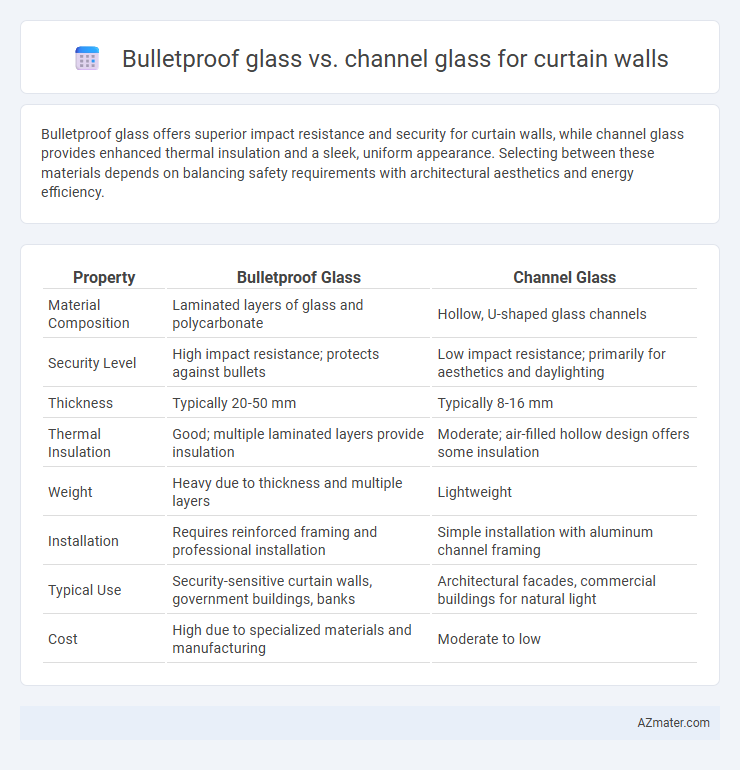Bulletproof glass offers superior impact resistance and security for curtain walls, while channel glass provides enhanced thermal insulation and a sleek, uniform appearance. Selecting between these materials depends on balancing safety requirements with architectural aesthetics and energy efficiency.
Table of Comparison
| Property | Bulletproof Glass | Channel Glass |
|---|---|---|
| Material Composition | Laminated layers of glass and polycarbonate | Hollow, U-shaped glass channels |
| Security Level | High impact resistance; protects against bullets | Low impact resistance; primarily for aesthetics and daylighting |
| Thickness | Typically 20-50 mm | Typically 8-16 mm |
| Thermal Insulation | Good; multiple laminated layers provide insulation | Moderate; air-filled hollow design offers some insulation |
| Weight | Heavy due to thickness and multiple layers | Lightweight |
| Installation | Requires reinforced framing and professional installation | Simple installation with aluminum channel framing |
| Typical Use | Security-sensitive curtain walls, government buildings, banks | Architectural facades, commercial buildings for natural light |
| Cost | High due to specialized materials and manufacturing | Moderate to low |
Introduction to Curtain Wall Glazing Options
Bulletproof glass enhances curtain wall systems by providing superior security and impact resistance, ideal for high-risk environments requiring robust protection without compromising transparency. Channel glass offers a sleek, modular design with thermal efficiency and natural light diffusion, supporting an aesthetically modern facade with ease of installation. Choosing between bulletproof glass and channel glass for curtain wall glazing depends on balancing safety requirements with design flexibility and energy performance.
What is Bulletproof Glass?
Bulletproof glass, also known as ballistic glass, is a laminated material consisting of multiple layers of polycarbonate and glass designed to resist penetration from bullets and other high-velocity projectiles, making it ideal for security-focused curtain wall applications. It provides robust impact resistance and enhances safety without compromising transparency or aesthetics in building facades. Compared to channel glass, which is primarily used for structural support and light diffusion, bulletproof glass prioritizes protective performance while maintaining architectural elegance.
What is Channel Glass?
Channel glass is a U-shaped glass profile commonly used in curtain wall systems for its structural strength and aesthetic transparency. Unlike bulletproof glass, which is laminated or tempered for high impact resistance, channel glass offers enhanced thermal insulation, light diffusion, and a sleek, seamless appearance in building facades. This makes channel glass an ideal choice for modern architectural designs prioritizing natural light and energy efficiency over ballistic protection.
Key Differences: Bulletproof vs Channel Glass
Bulletproof glass offers enhanced security with multi-layered, laminated construction designed to resist high-impact forces and ballistic threats, making it ideal for high-risk areas in curtain wall applications. Channel glass, by contrast, is a load-bearing, U-shaped tempered glass known for its translucency, thermal insulation, and sleek aesthetic, primarily used for daylighting and creating visually appealing facades. The key differences lie in bulletproof glass's emphasis on protection and safety versus channel glass's focus on design flexibility and energy efficiency within curtain wall systems.
Security Performance Comparison
Bulletproof glass offers superior security performance for curtain walls due to its multi-layered construction designed to resist high-velocity impacts and prevent penetration from ballistic threats. Channel glass, while providing aesthetic appeal and structural support, lacks the reinforced lamination necessary to withstand forced entry or gunfire, making it less effective for high-security applications. Security-critical installations favor bulletproof glass for its proven ability to protect occupants and assets against violent attacks.
Aesthetic and Design Flexibility
Bulletproof glass offers a sleek, seamless finish with high clarity, enhancing modern curtain wall aesthetics by providing unobstructed views and a sense of openness. Channel glass allows for unique design flexibility through its modular, translucent panels that create vibrant light diffusion and architectural texture, ideal for artistic facades. Combining these materials can optimize both security and visual impact, catering to diverse architectural styles and functional demands.
Installation Methods and Complexity
Bulletproof glass installation in curtain walls requires precise framing systems and high-tolerance sealants to securely accommodate its heavy, laminated layers, demanding specialized anchors and equipment for safety compliance. Channel glass installation involves sliding pre-fabricated glass channels into aluminum or steel frames with integrated seals, offering a faster and simpler process due to its modular, lightweight design. The complexity of bulletproof glass installation often results in longer project timelines and higher labor costs compared to the relatively straightforward assembly of channel glass curtain walls.
Acoustic and Thermal Insulation
Bulletproof glass offers superior acoustic insulation with noise reduction coefficients typically between 35-45 dB, effectively minimizing urban sound intrusion in curtain wall applications. Channel glass provides moderate thermal insulation with U-values ranging from 1.2 to 2.5 W/m2K, enhancing energy efficiency but lacks the high impact resistance of bulletproof glass. For projects prioritizing both acoustic protection and thermal performance, integrating multi-layered bulletproof glass with insulating interlayers outperforms channel glass in curtain wall systems.
Cost Analysis: Bulletproof Glass vs Channel Glass
Bulletproof glass typically incurs higher initial costs due to its multi-layered laminated construction and enhanced security features, making it significantly more expensive per square foot than channel glass. Channel glass, composed of hollow glass channels fixed with aluminum profiles, offers a cost-effective alternative by reducing installation time and material expenses, suitable for aesthetic curtain wall designs with moderate safety requirements. Maintenance and replacement costs favor channel glass as its modular design simplifies repairs, whereas bulletproof glass demands specialized handling and higher long-term investment.
Best Applications for Each Glass Type
Bulletproof glass excels in high-security curtain wall applications such as government buildings, banks, and embassies where impact resistance and protection against forced entry are critical. Channel glass is ideal for commercial and institutional buildings requiring natural light diffusion, thermal insulation, and sleek architectural aesthetics with minimal framing. Selecting bulletproof glass is essential for safety-focused facades, while channel glass suits projects prioritizing visual transparency and energy efficiency.

Infographic: Bulletproof glass vs Channel glass for Curtain wall
 azmater.com
azmater.com